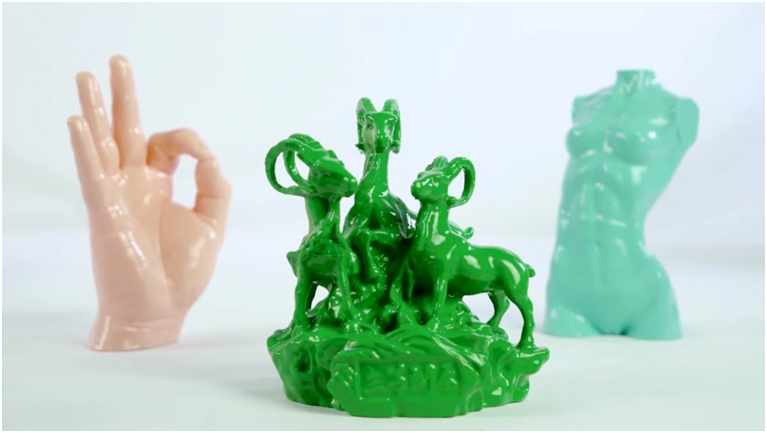![[Art 3D Printed Using PLA Plastics / Source: Polymaker]](https://fabbaloo.com/wp-content/uploads/2020/05/Plant2_img_5eb0917dcbdf9.png)
Charles Goulding and Peter Favata of R&D Tax Savers discuss use of bioplastics in 3D printing.
Bioplastics May Be The Future of 3D Printing
Plastic pollution is a growing global problem we’re facing today, as some plastics can take up to 1,000 years to decompose. When large amounts are gathered in an area they can harm plants, animals, or humans in the vicinity. One way we are trying to combat this issue is by creating plant-based plastics that are compostable.
For a long time the most commonly used plastic for 3D printing was ABS (Acrylonitrile Butadiene Styrene), which is made out of non-renewable oil-based resources. Now there are new types of plastics that can be used as material for 3D printers. PLA (Polylactic Acid) is manufactured out of plant-based resources such as corn starch or sugar cane, making PLA much better for the environment because they are made from renewable resources.
ABS versus PLA Plastics
Both ABS and PLA filaments have their specific applications based on their characteristics. ABS is a very strong and sturdy plastic which makes it better used for things such as car parts and helmets. It has a higher melting point than PLA, which eliminates concerns about it deforming when exposed to hot temperatures.
![[3D Printed Hockey Helmets using ABS Plastics / Source: hackaday.com ]](https://fabbaloo.com/wp-content/uploads/2020/05/Plant1_img_5eb0917e33fad.png)
However, ABS is not without its shortcomings. As mentioned previously, ABS is a non-renewable resource, as it is made from petrochemical compounds that undergo chemical reactions in order to form the plastic polymer. It’s also been known to be more difficult to print with, as the plastic must be printed on a heated surface or it will deform. A proper ventilation system is also necessary when printing with ABS due to the fumes emitted while printing. Another limitation of ABS is that it is considered unsafe to use with anything that will come into contact with food. This is because ABS contains toxic chemicals which could leach into food and eventually, the consumer.
PLA plastics, on the other hand, are more environmentally friendly. Unlike other thermoplastics that are petroleum-based, they are made from renewable resources such as corn starch, tapioca roots, or sugar cane. PLA is also much easier to print with compared to ABS; printing can be completed at higher speeds without a heat controlled surface or harmful emissions. Not only do they tend to have a smoother and more appealing appearance, but they can also be used for food packaging being that they are made from food-based materials.
However, there are some major limitations to using PLA plastics. Primarily, they are less sturdy then ABS plastics and can become deformed from heat, making them unsuitable for high stress applications.
Compostable Plastics
PLA plastics are compostable products. This is different from biodegradable in that compostable products require a specific setting to breakdown. Under the right conditions, a plastic that is compostable will break down in as little as three months, whereas biodegradable plastics breakdown over time, no matter the conditions they are kept in. This may pose challenges for 3D printing because the material could potentially start to breakdown while in use.
Compostable products have been in the news lately. In a Breitbart article dated August 19th, 2019 it was recently discovered that many of the ‘compostable’ fiber bowls that fast food restaurants and supermarkets use actually have a toxic chemical in them called Perfluorooctanoic acid (PFOA). This chemical prevents the fiber bowls from breaking down and has been linked to numerous health problems, including thyroid disorders and kidney and testicular cancers. This might be cause for concern when companies claim a product is compostable or biodegradable.
Individuals and companies who engage in 3D printing should be eligible for R&D Tax Credits, which are briefly described below.
The Research & Development Tax Credit
Enacted in 1981, the now permanent Federal Research and Development (R&D) Tax Credit allows a credit that typically ranges from 4%-7% of eligible spending for new and improved products and processes. Qualified research must meet the following four criteria:
-
Must be technological in nature
-
Must be a component of the taxpayer’s business
-
Must represent R&D in the experimental sense and generally includes all such costs related to the development or improvement of a product or process
-
Must eliminate uncertainty through a process of experimentation that considers one or more alternatives
Eligible costs include US employee wages, cost of supplies consumed in the R&D process, cost of pre-production testing, US-based contractor research expenses, and certain costs associated with developing a patent.
On December 18, 2015, President Obama signed the PATH Act, making the R&D Tax Credit permanent. Beginning in 2016, the R&D credit can be used to offset Alternative Minimum tax for companies with revenue below $50MM and, startup businesses can obtain up to $250,000 per year in payroll tax cash rebates.
Conclusion
There are many great opportunities for plant-based plastics for 3D printing. As the concern for non-sustainable plastic material continues to grow, we expect to there to be more creative applications of plant-based plastics in the 3D printing industry.











An inventive designer has developed a method for producing 3D paper objects using recycled paper and 3D printed molds.